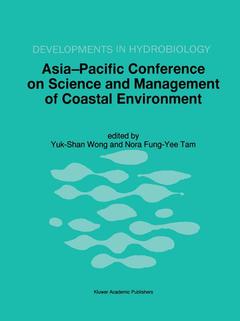1. Acid Exposure in Euryhaline Environments: Ion Regulation and Acid Tolerance in Larval and Adult Artemia franciscana; B.R. McMahon. 2. Effects of Two Oil Dispersants on Phototaxis and Swimming Behaviour on Barnacle Larvae; P.K.S. Lam. 3. Heavy Metal Accumulation in Tissue/Organs of a Sea Cucumber, Holothuria leucospilota; Jun Xing, F.S. Chia. 4. Mapping and Characterization of Mangrove Plant Communities in Hong Kong; N.F.Y. Tam. 5. Gas Exchange Responses of the Mangrove, Avicennia marina to Waterlogged and Drained Conditions; G. Naidoo. 6. Mangrove Wetland as Wastewater Treatment Facility: A Field Trial; Yuk-Shan Wong. 7. Wood Structure of Aegiceas corniculatum and its Ecological Adaptations to Salinities; Qiang Sun. 8. Accumulation and Distribution of Heavy Metals in a Simulated Mangrove System Treated with Sewage; N.F.Y. Tam. 9. Incidence of Heavy Metals in the Mangrove Flora and Sediments in Kerala, India; G. Thomas. 10. Tolerance of a Mangrove Plant, Aegiceras corniculatum, to Synthetic Sewage of Various Strengths; Yuk-Shan Wong. 11. Size-Fractionated Productivity and Nutrient Dynamics of Phytoplankton in Subtropical Coastal Environments; Hai-Li Wang. 12. Long-Term Changes in Hydrography, Nutrients and Phytoplankton in Tolo Harbour, Hong Kong; Ying-Kit Yung. 13. Environmental and Nutritional Factors which Regulate Population Dynamics and Toxin Production in the Dinoflagellate Alexandrium catenella; D.K.O. Chan. 14. Are Changes in N:P Ratios in Coastal Waters the Key to Increased Red Tide Blooms? J. Hodgkiss. 15. A Comparison of Marine Planktonic Diatoms with Diatoms in a Victoria Harbour Sediment Core; M. Dickman. 16. The Essential Elements of Science and Management in Coastal Environmental Management; Thia-Eng Chua. 17. Status, Problems, and Prospects of Stock Enhancement in Taiwan; I-Chiu Liao. 18. Human Influence or Natural Perturbation in Oceanic and Coastal Waters &endash; Can we Distinguish Between Them? J.-O. Strömberg. 19. Toxic Events in the Pacific Coastline of the Baja California Peninsula in Mexico During 1992&endash;1995: Origin and Impact; A. Sierra-Beltran. 20. A Biological Survey of Ballast Water in Container Ships Entering Hong Kong; Ka-Hou Chu. 21. Decision Making Processes in Ecological Risk Assessment Using Copper Pollution of Macquarie Harbour from Mt. Lyell, Tasmania, as a Case Study; J. Twining. 22. Spatial Variations of Size-Fractionated Chlorophyll, Cyanobacteria and Heterotrophic Bacteria in the Central and Western Pacific; I-Hsun Ni. 23. Reproductive Function State of the Scallop Mizuhopecten yessoensis Jay from Polluted Areas of Peter the Great Bay, Sea of Japan; M. Vaschenko. 24. The Use of Malformations in Pelagic Fish Embryos for Pollution Assessment; H.V. Westernhagen. 25. Polynuclear Aromatic Hydrocarbons (PAHs) in Fish from the Red Sea Coast of Yemen; H. Heba. 26. The Application of Gene Transfer Techniques to Marine Resource Management: Recent Advances, Problems and Future Direction; F.Y.T. Sin. 27. Probiotic Effect of Lactic Acid Bacteria in the Feed to Atlantic Cod (Gadus morhua) Fry; A. Gildberg. 28. Translocation of Assimilates in U




